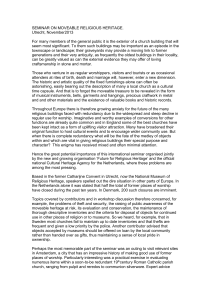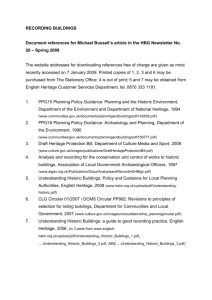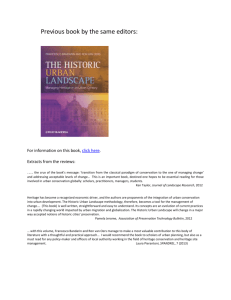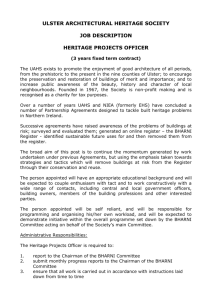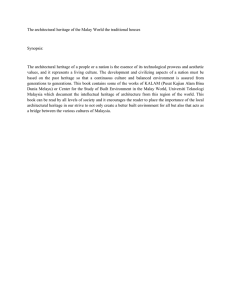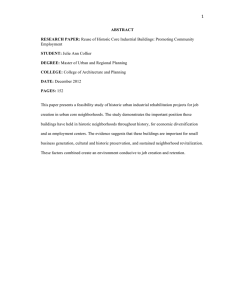Heritage Building Remodeling vs. Restoration: An Architectural Debate
advertisement
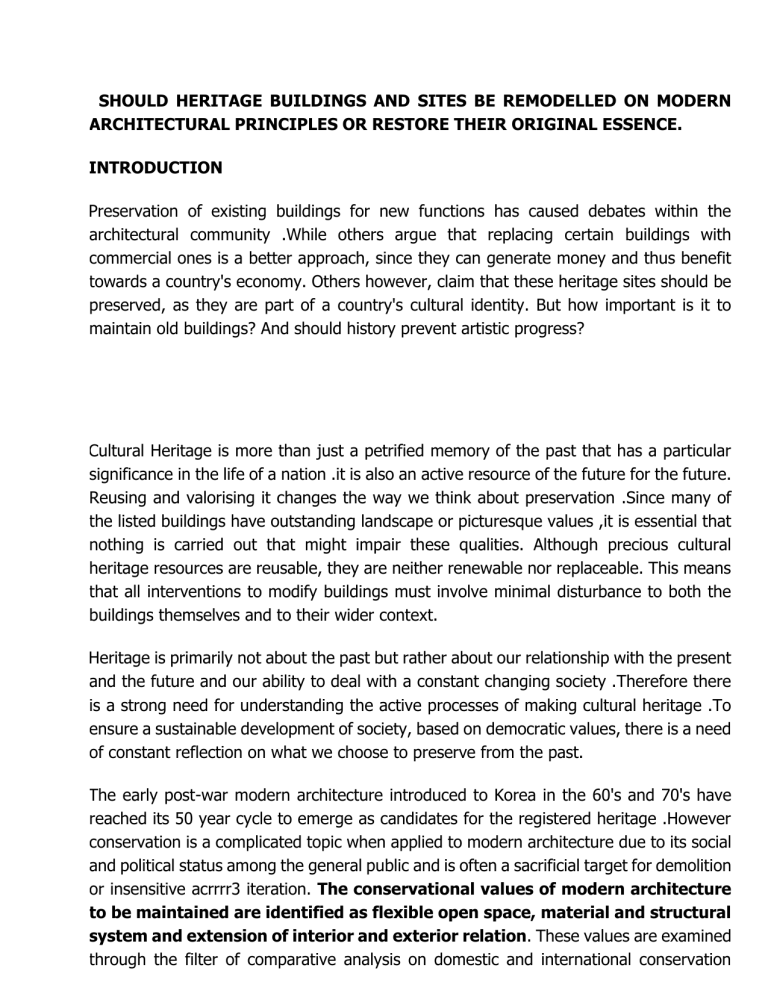
SHOULD HERITAGE BUILDINGS AND SITES BE REMODELLED ON MODERN ARCHITECTURAL PRINCIPLES OR RESTORE THEIR ORIGINAL ESSENCE. INTRODUCTION Preservation of existing buildings for new functions has caused debates within the architectural community .While others argue that replacing certain buildings with commercial ones is a better approach, since they can generate money and thus benefit towards a country's economy. Others however, claim that these heritage sites should be preserved, as they are part of a country's cultural identity. But how important is it to maintain old buildings? And should history prevent artistic progress? Cultural Heritage is more than just a petrified memory of the past that has a particular significance in the life of a nation .it is also an active resource of the future for the future. Reusing and valorising it changes the way we think about preservation .Since many of the listed buildings have outstanding landscape or picturesque values ,it is essential that nothing is carried out that might impair these qualities. Although precious cultural heritage resources are reusable, they are neither renewable nor replaceable. This means that all interventions to modify buildings must involve minimal disturbance to both the buildings themselves and to their wider context. Heritage is primarily not about the past but rather about our relationship with the present and the future and our ability to deal with a constant changing society .Therefore there is a strong need for understanding the active processes of making cultural heritage .To ensure a sustainable development of society, based on democratic values, there is a need of constant reflection on what we choose to preserve from the past. The early post-war modern architecture introduced to Korea in the 60's and 70's have reached its 50 year cycle to emerge as candidates for the registered heritage .However conservation is a complicated topic when applied to modern architecture due to its social and political status among the general public and is often a sacrificial target for demolition or insensitive acrrrr3 iteration. The conservational values of modern architecture to be maintained are identified as flexible open space, material and structural system and extension of interior and exterior relation. These values are examined through the filter of comparative analysis on domestic and international conservation SHOULD HERITAGE BUILDINGS AND SITES BE REMODELLED ON MODERN ARCHITECTURAL PRINCIPLES OR RESTORE THEIR ORIGINAL ESSENCE. INTRODUCTION Preservation of existing buildings for new functions has caused debates within the architectural community .While others argue that replacing certain buildings with commercial ones is a better approach, since they can generate money and thus benefit towards a country's economy. Others however, claim that these heritage sites should be preserved, as they are part of a country's cultural identity. But how important is it to maintain old buildings? And should history prevent artistic progress? Cultural Heritage is more than just a petrified memory of the past that has a particular significance in the life of a nation .it is also an active resource of the future for the future. Reusing and valorising it changes the way we think about preservation .Since many of the listed buildings have outstanding landscape or picturesque values ,it is essential that nothing is carried out that might impair these qualities. Although precious cultural heritage resources are reusable, they are neither renewable nor replaceable. This means that all interventions to modify buildings must involve minimal disturbance to both the buildings themselves and to their wider context. Heritage is primarily not about the past but rather about our relationship with the present and the future and our ability to deal with a constant changing society .Therefore there is a strong need for understanding the active processes of making cultural heritage .To ensure a sustainable development of society, based on democratic values, there is a need of constant reflection on what we choose to preserve from the past. The early post-war modern architecture introduced to Korea in the 60's and 70's have reached its 50 year cycle to emerge as candidates for the registered heritage .However conservation is a complicated topic when applied to modern architecture due to its social and political status among the general public and is often a sacrificial target for demolition or insensitive acrrrr3 iteration. The conservational values of modern architecture to be maintained are identified as flexible open space, material and structural system and extension of interior and exterior relation. These values are examined through the filter of comparative analysis on domestic and international conservation standards, along with cross-examination on recently renovated local works performed on the modern architecture of the period. Remodelling the architectural heritage buildings and sites does not ensure the survival of the country's sense of place and its very character in a globalizing environment. It does not offer the opportunity not to only conserve the past but also to define the future. But again it provides alternate avenues for employment and a parallel market for local building materials and technologies, which needs to be taken into account when resources for development are severely constrained. This living heritage also has symbiotic relationships with the natural environments within which it originally evolved. Understanding this interdependent ecological network and conserving it can make a significant contribution to improving the quality of the environment. Maintaining a building's original essence is to maintain the significance of the architectural site or heritage building. Significance is constituted in both the tangible and intangible forms. The tangible heritage includes historic buildings of all periods, their setting in the historic precincts of cities and their relationship to the natural environment .It also includes culturally significant modern buildings and towns. Then we have the Intangible heritage which includes the extant culture of traditional building skills and knowledge, rites and rituals, social life and lifestyles of the inhabitants, which together with the tangible heritage constitutes the living heritage. Both tangible and intangible heritage and especially the link between them should by all means be conserved. Remodelling of architectural heritage buildings and sites must retain meaning for the society in which it exists .This meaning may change over time ,but taking it into consideration ensures that heritage buildings and sites will at all times have a contemporary logic underpinning its practice .This necessitates viewing conservation as a multi-disciplinary activity. AUTHENTICITY The traditional knowledge systems and the cultural landscape in which it exists ,particularly If these are living should define the authenticity of the heritage value to be conserved .In the absence of such contexts ,the official and legal guidelines particularly. as defined by the nara document on authenticity of the architectural heritage and site. Traditional knowledge systems and cultural landscapes vary from one regional or cultural context to another or within the same region or culture, thus the values of living architectural heritage can differ from one context to another reflecting the cultural diversity of the country. In each case however, conservation should faithfully reflect the significant values, which define the heritage. CONJECTURE It would be easy to surmise that modern heritage is well loved, cared for, and conserved. However, many important twentieth-century places remain unprotected. Since there is not enough widespread recognition and support for the conservation of twentieth-century buildings, it became important to reflect on how the practice of conserving modern architecture has advanced, in order to identify the area on which future efforts should be concerned. This prompted the Getty Conservation Institute (GCI) to launch the Conserving Modern Architecture Initiative in 2012. Where the initiative aims to advance practice in the area of conservation through compressive research and an implementation program, which includes materials-based research that investigates innovative techniques to arrest decay in buildings while sustaining them into the future. Historic objects must be retained If its existence is not bought at the price of bad living conditions for the population that is compelled to live in it. When the opportunity is afforded to remove its restricting influence on development by the diversion of traffic round it or the shifting of the focal point. An aesthetic adaptation of new parts of the city to the historic area has a catastrophic effect on the development of a city and is not to be desired. By the demolition of slum dwellings surrounding the historic monuments, green areas can be created, which improve the hygienic conditions in those areas. Conjecture Local master builders build, rebuild, restore, renew and make additions/alterations to historic buildings in response to contemporary exigencies or evolving local needs of the community; they must be encouraged to follow their traditions even when there is no available evidence in the form of documentation, oral histories or physical remains of previous structures. Appropriate craftspeople for undertaking such work should be identified as described in article 5.1.4 An exact replacement, restoration or rebuilding must be valued when it ensured continuity of traditional building practices. Conjectural restoration or rebuilding must never less respect the overall spatial and volumetric composition of historic settings. The parameters of the historical setting should be defines through comprehensive urban design studies. These parameters should also guide new urban development in the vicinity of heritage building. Historic buildings and their remains, which belong to the monumental heritage of a society, should be protected from further deterioration, restored and adapted to modern requirements and modern social changes. The restoration of historic building that includes energy refurbishment measures while maintaining the authentic appearance and materialization of the building will ensure successful reuse of restored building. The subject of this research is the restoration of the dining room within the Zica Monastery property, in the village of Zica near KraIjevo, the town in Serbia, in terms of energy efficiency and modern conservation requirements. Heritage buildings are architectural and historic monuments, and their preservation is crucial in terms of passing on the cultural identify to the future generations. What characterizes in the dining room is its unchanged role and function in the development of monastic life in the last ninety years. Architectural heritage and historic buildings are primarily influenced by the bioclimatic design principles, specific resilient architectural structure and strategic design choice of durable construction materials, as well as by characteristic free land space and greenery they are surrounded with. Their sustain. In order to archive a more satisfying result for the architectural community, it may be necessary to override the professional imperative to adhere to the principles governing the conservation of legally protected monuments. This is acceptable when dealing with unprotected architectural heritage buildings and sites. Not remodelling seeks strategies economically to archive maximum protection of the significant values of the architectural heritage buildings and sites. If a historic structure has outlived its significance and its meanings to local people are lost, it may be preserved as a ruin or, if circumstances do not permit that, left undisturbed to meet its natural end. Where the existence of a cultural resource is under severe threat by natural calamities or man-made hazards, the buildings may be dismantled and reassembled at another appropriate site after undertaking thorough documentation of its extant condition. The concept of jeernodharanam, or relegation of what decays, must guide the nature of conservation .This beliefs is fundamental to conserving traditional ways of buildings and maintaining the continuity of local knowledge systems. Today however working with existing buildings, repairing and restoring them for continued use has become a creative challenge. The process of wholeheartedly changing a building is typically called adaptive reuse. According to the contemporary conservation theory and practice, adaptive reuse is considered to be an important strategy towards the conservation of cultural building and sites heritage. Altering existing buildings for new functions has not been a new phenomenon in the past buildings that were structurally secure have been adapted to fit changed needs or new functions without questions or theoretical reflections. For example, during the French revolution, religious buildings were transformed for industrial purposes and military use. But it is really a good idea to transform classical buildings into modern styles. While it’s true that architecture keeps on evolving, l honestly believe that long standing structures should be preserved as living testaments of our history and culture. Naturally, these old structures will deteriorate in time. But there are several ways to repair and restore them without altering the original design. Unfortunately, these buildings ended up losing their former glory for eternity and it’s a bit infuriating to see how modern architecture simply erased the historical elements in them. Of course, the result is utterly disappointing, while we admit that modern architecture has its advantages over classical architecture, this should not be used as an excuse to efface the architectural styles of the buildings. Sure, industrialized materials used in modern structures such as glass and steel look perfect in contemporary buildings homes. But the same can’t be said for centuries old structures .At least the architects who renovated these have learned an important lesson. And we are quite sure you will agree with us when we say that cultural heritage such as these historic buildings should be preserved, not redesigned. Historic buildings are an integral part of today’s cities and their preservation is an element of basic architecture. Elizabeth Fisher discovers what it takes to successfully blend old and new structural designs in modern metropolises. The face of many historic cities has changed over the past few decades with varying architectures and newer mushrooming across whole areas of towns. Today, ancient centres and buildings, such as pre-war office blocks and churches, intermingle with futuristic skyscrapers and ultra-modern financial districts. A building occupies a specific place .it has its own identity and a distinct relationship with its surroundings ,involving not just its immediate neighbours particular building or place can be influenced by its context .it’s just a small element within a huge collage of different points and references .Rehabilitation acknowledges the need to alter or add to a historic property to meet continuing or changing uses while retaining the property’s historic character .Restoration depicts a property at a particular period of time in its history while removing evidence of other periods. When remodelling a heritage building and sites a few tips have to be taken into consideration. -Ensure that a building can support modern amenities When first getting started with a historic building remodelling project, there is a temptation to immediately start picking out new cabinets, crown moulding and appliances, but the first step should be more practical than aesthetic. Historic buildings time after time have complications that directly affect the building’s integrity. When remodelling a heritage building or sites it is preferable to retain and repair as much of the original structural system as possible .However ,if you find that more amenities need to be added ,you will first want to make sure that the building can support such additions. Some heritage buildings have structural systems may require sensitivity when altering or repairing its elements and in some cases .it may be necessary to add an entirely new structural system to strengthen the existing system with modern innovations. -Maintain the building’s character The next step of the remodelling should be to determine the building’s significance to its surrounding community .Historic buildings have seen a lot of history throughout the years, but they also have a rich architectural features, design details, and unique layouts that have since disappeared from modern construction. Determining a building’s historical, cultural or architectural significance is important for raising awareness, but it can also help when it comes to applying for grants or funding, as well as meeting specific codes guidelines. Did a historical event occur here? Was it the first building of its kind in the area? These are only a couple of questions that need to be answered before making any drastic changes to the building’s appearance. Working with local historians, community leaders, and past owners to acquire as much information about the building as possible .Remodelling heritage buildings allows the chance to keep the craftsmanship and local history alive. -Retain As Much of the Original Building as Possible The character of a heritage building should be respected as much as possible when incorporating new additions .No matter how big the changes being made are, each can have a significant impact on the building over time, and specific care should be taken to avoid any potential loss of integrity. Any remodelling to be considered on a heritage building or site should be sympathetic to the original architect’s specific design intent and they should also be installed to avoid damage to character-defining features and finishes. Working Around the historic fabric as much as possible. If a disturbance is unavoidable, any replacement should match the design, colour, texture and materials of the original as closely as possible substituting materials is unavoidable, and they should convey the overall form, design. -Paying Close Attention to Building codes and Historic Building Regulations Not only do remodelling projects need to place priority on the building’s resources .but they also need to prioritize the safety of the building’s occupants .So it is extremely important to also address building codes and regulations ,as well as safety and security measures Designers, facility managers and code officials should be involved early on in the planning and design process so they are given the proper amount of time to look at potential issues and challenges that may arise within the historic property .Application of such codes should be done in consultation with code authorities and preservation experts to ensure they address issues such as egress, fire and smoke separation, detection and suppression, as well as operational considerations. -Asking For Expert Advice Last but certainly not least, it’s always wise to assemble a team of experts to help .A heritage building remodelling projects is no small task, and it could prove to be quiet useful to have a team of experienced people to help provide assistance throughout the remodelling process while also understanding the ultimate goal of remodelling the property. A contactor and an inspector can help estimate the amount of work that needs to be done and its cost while a researcher can help ensure your purchase the right materials for the job .We understand you may feel like tackling this sort of project on your own, but you will most certainly want talented people around the project when remodelling of a heritage building or sites. Reference list .White, Michael. (2003). De Stijl and Dutch Modernism, Manchester: Manchester University Press. .Weston, Richard. (2004). Key Buildings of the Twentieth Century: Plans, Sections, Elevations. .New York: W. W. Norton & Company. pp.48-49, 60-61 UNESCO. (2001). Tugendhat Villa in Brno, World Heritage List. Available through: http://whc.unesco.org/en/list/1052 .Brno City Museum. (2012). Villa Tugendhat Official Website. Available through: http://www.tugendhat.eu/en .Barasch, Moshe. Theories of Art, 2 – From Impressionism to Kandinsky (New York University Press, New York, 1999) .Herbert, Robert L. (Edited by) Modern Artists on Art (Prentice-Hall, New Jersey, 1964) .See Jean-Louis Cohen’s entry on Bat’a in: Le Corbusier, une encyclopédie, pp 62–67. See, also, Gilles Ragot: Le Corbusier et l’exposition, in: Paris, 1937: cinquantenaire de l’Exposition internationale des arts et techniques dans la vie moderne, ed. Bertrand Lemoine, Paris, 1987, pp 72–79. . Le Corbusier: Creation is a Patient Search, trans. James Palmes, New York, 1960, p 186. IMAGE REFERENCE
